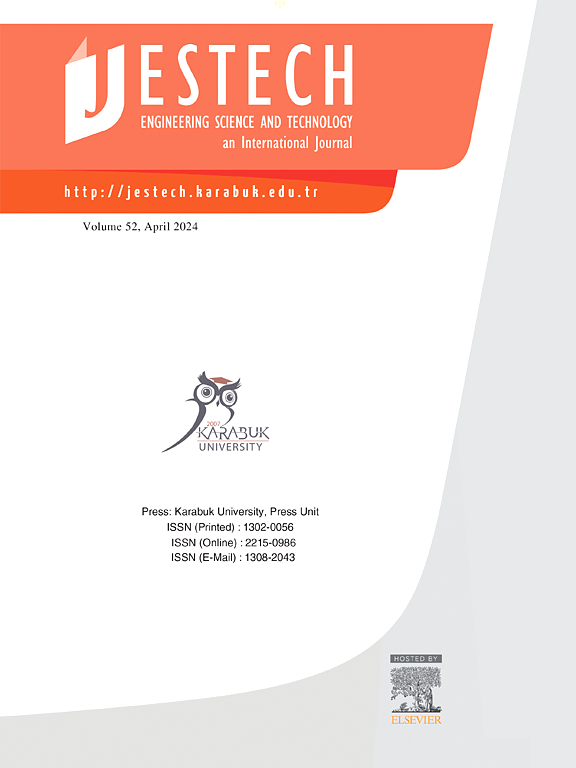Solving the 3D Multi-Objective Dynamic AUV Path Planning Problem Based on the Improved Morphin-Altruistic NSGAII Algorithm
IF 5.1
2区 工程技术
Q1 ENGINEERING, MULTIDISCIPLINARY
Engineering Science and Technology-An International Journal-Jestech
Pub Date : 2025-07-10
DOI:10.1016/j.jestch.2025.102137
引用次数: 0
Abstract
As ocean exploration delves deeper, autonomous underwater vehicles (AUVs) have become essential tools for ocean missions. Dynamic path planning seeks to find an optimal path for AUVs from a start point to the target while avoiding collisions with moving obstacles. However, current dynamic path planning faces several challenges such as three-dimensional environments and multi-objective problems, resulting in impractical solutions. To address these challenges, this paper proposes improved Morphin-Altruistic Nondominated Sorting Genetic Algorithm II (ANSGAII). More specifically, contributions presented in this paper are as follows: (1) An improved Three-dimension multi-objective path planning model is proposed, which incorporates depth considerations and simultaneously optimises for path length, safety, and smoothness. An enhanced path collision detection mechanism is also designed. (2) The ANSGAII, inspired by altruism in animal populations, is proposed to enhance optimisation efficiency and reduce computational load by transferring update opportunities from the weak to the strong individuals. (3) The best path is selected based on weighted criteria, and the Morphin algorithm is utilised to timely get around dynamic dangers. Experimental results demonstrate that the paths generated by the improved Morphin-ANSGAII algorithm better balance the objectives and effectively help AUVs avoid dynamic obstacles.
基于改进吗啡利他NSGAII算法求解三维多目标动态AUV路径规划问题
随着海洋探索的深入,自主水下航行器(auv)已成为海洋任务的重要工具。动态路径规划旨在为auv找到从起点到目标的最优路径,同时避免与移动障碍物发生碰撞。然而,当前的动态路径规划面临着三维环境和多目标问题等挑战,导致解决方案不切实际。为了解决这些问题,本文提出了改进的Morphin-Altruistic nondominant Sorting Genetic Algorithm II (ANSGAII)。具体而言,本文的贡献如下:(1)提出了一种改进的三维多目标路径规划模型,该模型考虑了深度因素,同时对路径长度、安全性和平滑性进行了优化。设计了一种增强的路径碰撞检测机制。(2)受动物群体利他主义的启发,提出了ANSGAII算法,通过将更新机会从弱个体转移到强个体,从而提高优化效率,减少计算量。(3)基于加权准则选择最优路径,利用Morphin算法及时规避动态危险。实验结果表明,改进的Morphin-ANSGAII算法生成的路径能够更好地平衡目标,有效地帮助水下机器人避开动态障碍物。
本文章由计算机程序翻译,如有差异,请以英文原文为准。
求助全文
约1分钟内获得全文
求助全文
来源期刊

Engineering Science and Technology-An International Journal-Jestech
Materials Science-Electronic, Optical and Magnetic Materials
CiteScore
11.20
自引率
3.50%
发文量
153
审稿时长
22 days
期刊介绍:
Engineering Science and Technology, an International Journal (JESTECH) (formerly Technology), a peer-reviewed quarterly engineering journal, publishes both theoretical and experimental high quality papers of permanent interest, not previously published in journals, in the field of engineering and applied science which aims to promote the theory and practice of technology and engineering. In addition to peer-reviewed original research papers, the Editorial Board welcomes original research reports, state-of-the-art reviews and communications in the broadly defined field of engineering science and technology.
The scope of JESTECH includes a wide spectrum of subjects including:
-Electrical/Electronics and Computer Engineering (Biomedical Engineering and Instrumentation; Coding, Cryptography, and Information Protection; Communications, Networks, Mobile Computing and Distributed Systems; Compilers and Operating Systems; Computer Architecture, Parallel Processing, and Dependability; Computer Vision and Robotics; Control Theory; Electromagnetic Waves, Microwave Techniques and Antennas; Embedded Systems; Integrated Circuits, VLSI Design, Testing, and CAD; Microelectromechanical Systems; Microelectronics, and Electronic Devices and Circuits; Power, Energy and Energy Conversion Systems; Signal, Image, and Speech Processing)
-Mechanical and Civil Engineering (Automotive Technologies; Biomechanics; Construction Materials; Design and Manufacturing; Dynamics and Control; Energy Generation, Utilization, Conversion, and Storage; Fluid Mechanics and Hydraulics; Heat and Mass Transfer; Micro-Nano Sciences; Renewable and Sustainable Energy Technologies; Robotics and Mechatronics; Solid Mechanics and Structure; Thermal Sciences)
-Metallurgical and Materials Engineering (Advanced Materials Science; Biomaterials; Ceramic and Inorgnanic Materials; Electronic-Magnetic Materials; Energy and Environment; Materials Characterizastion; Metallurgy; Polymers and Nanocomposites)
 求助内容:
求助内容: 应助结果提醒方式:
应助结果提醒方式:


